|

That is: of the noble and titled Neapolitan families
belonging to the Noble Circles of Naples, registered in
the Neapolitan Gold Book, to the Neapolitan Regional
Register or who played a role in the affairs of Southern
Italy. |
|
 |
THE d’AURIA FAMILY |
|
Coat of Arms:
light blue with six-rung ladder placed obliquely,
accompanied by two eight pointed stars, one placed at
the head and the other at the base – all in gold. (From
the text of the ancient privilege “Insigna
et vero scuto – Campo azulo cum duabus stellis aureis et
scala aurea sistante inmedio”.)
(1) |
|
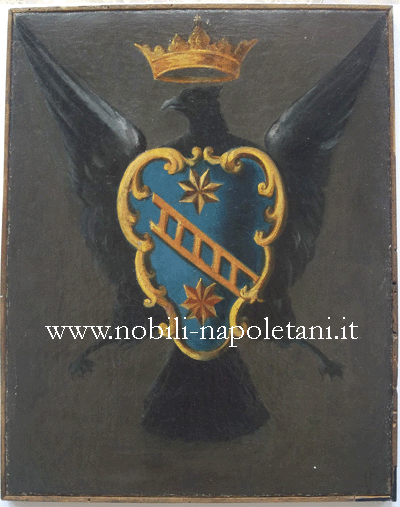
COAT OF ARMS OF THE d’AURIA FAMILY – oil painting |
|
The name of d’Auria, formerly de Auria had its origin
from an Auria
(2)
of Lucera of which clear mention is made in a document
existing in a collection of parchments from the
Benedettini archives of Cava dei Tirreni of the year 990
3).
In the same parchment an
Optabiano
is mentioned, descendent of
Auria
who is also named in an “ancient charter in the archives
of the Sanctae Sophiae urbis beneventanae monasteries”.
“Imperii basilii et cum eo regnante Costantino frate
eius, mense Februario, II indictione, Luceriae, Castaldi
Polcari, Joannes, Iduini, Optabiano ordinati a Theodoro
Imperiali ex cubido Longobardie sumus residente in ista
civitate Lucerie ad senorantum indicantum, regendum,
tunc ad nostrae potestatis palatium cecidit una casa”.
Optabiano is,
therefore, one of the Gastaldi of Lucera in the year of
1013
(4).
Princivalle
d’Auria is remembered in the Great Archive of the Royal
Chamber as possessing half of the “Pantano” (lake
and land area)
of S. Giovanni Rotondo: “Pro
informationi Imperialis Curiae, Dominus Princivallus de
Auria possidet meditate Pantani, in territorio Casalis
Johannis Rotundi, tempore Henrici sexti Imperatoris, in
anno 1195”
(5).
Fabrizio,
descendent of Princivalle, was royal courtier of
King Charles I of Angiou
Tommaso, son of
Fabrizio (AD 1270) was “Equitum Dux”, with
King Charles II of Angiou,
under whose banners Tommaso was charged to drive out the
Saracens from Lucera in 1309.
Antonio (AD.
1310) son of Tommaso, as well as services to King
Charles II, he had the privilege of being appointed
Steward to Queen, Lady Sancha of Aragon, daughter of the
King of Majorca and second wife of Roberto of Angiou in
the year 1340.
Antonio was son
of his father Antonio (1310). In 1334 both father and
son were remunerated by King Roberto d’Angiò with 100
ounces for life, in the
Royal estates of Gabelle. |
|
 |
|
The same Antonio was royal courtier of King Andrea who,
in 1343, bestowed on him the honour and privilege of a
coat of arms.
Tommaso (1458 –
Captain of Knights and Chief Steward to Alfonso of
Aragon) – bestowal by Giovanni of Angiou 1461 (3a parts
of iron and steel from the ports of Manfredonia and
Fortore) – Privilege of Ferdinando 21/2/1473 – bestowal
by King Ferdinando of 15 wagons of grain from Fortore or
Manfredonia. Tommaso d’Auria, as mayor of Lucera, was
received in audience by King Ferdinand of Aragon in 1459
with regard to the discipline of the territory, as
privilege given in Barletta on the 7th of
February 1459. In the summary of the Aragon Chancery of
Naples page 49, one can read:
“1489 21st July – Naples (Castelnuovo) King
Ferdinando I.
“I confirm to Tommaso d’Auria of Lucera, the chapter
allotted on the 21st February 1483, in which
is pardoned any debt contracted by Tommaso and claimed
by royal tax collectors, relative to the administration
of the royal estate holding situated in Capitanata given
to him in the time of Alfonso, with the prohibition to
the authorities of harassing the said Tommaso in any
way, also in cases of willful default or fraud committed
in the administration of the said estate. The King,
under the same privilege, pardons our Tommaso de Auria
of the City of Lucera of any crimes and offenses, any
guilt or punishment for all and every offense or crime
committed, including even lese-majesty if necessary.
Furthermore, the King exonerates Tommaso from the
conduction of the said royal estate and gives him, for
the duration of his life, 15 wagons of wheat per year
tax free to be drawn from the Port of Manfredonia or
Fortore. This privilege, dated 1473, is extended to the
brother and heir of Tommaso, the 25th July
1484”.
Nicola, brother
of Tommaso – 1461: bestowal by Giovanni of Angiou as
done for
Tommaso, of the family of Ferdinando I (14/8/1463);
privileges 1463, 1475, 25/7/1484. Governor of Lucera.
According to the Chronicles of the era
“Ferdinando II was one night in Benevento where he was
housed … departing for Lucera, by nightfall entered the
house of Nicola d’Auria with whom he consulted the
entire night … early in the morning he started on his
way, chasing rebels throughout the Kingdom and the said
Nicola lent him 300 guilders”.
The historian Amelj in his work “The history of the City
of Lucera” writes “We transcribe a letter from King
Ferrante I of Aragon, addressed to Menelao of Mobilia
and to Nicola d’Auria, not only to reaffirm the nobility
of these two families, but also to
highlight some particulars
relevant to historical facts of our City”.
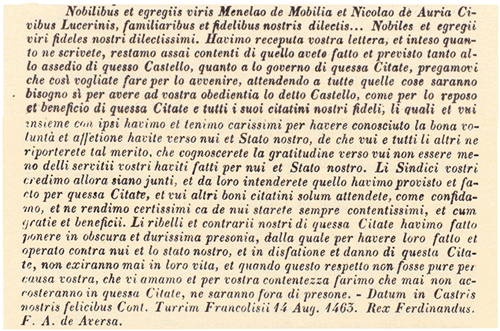
The Cistercian monk, Placido Troyli
(6)
mentions Nicola d’Auria among the “soldiers who were in
Lucera at the time of King Ferrante I and of his father,
Alfonso of Aragon”.
Marc’Antonio
d’Auria, Cavalry Captain in the Imperial Army of Charles
V of Augsburg – Spain. This great Emperor, granted with
Privilege, 1 December 1540, to
“the Nobleman Marco Antonio d’Auria of the City of
Lucera of our Kingdom of Sicily, hitherto faithful to us
and invited his loyalty in this last Germanic war
against the Duke of Saxony (Schmalkaldischer Krieg
1546-1547) and for these and many services to us from
him, and since we are maximally aware of the services
rendered by the Nobleman Marco Antonio d’Auria in our
service as Captain, we welcome him to our certain
knowledge as family and regular commensal at our table,
according to the tradition of our House and also restore
him to the Consortium of Families and we number him
among our commensals, like the other Nobles and our
Families. To him and to his descendants, and confirm the
Feud commonly called “Lo
Saracino” near Lucera, already granted to said
Family by our ancestors and then again granted by King
Alfonse II, our most glorious blood relative for the
many services given to him by
Alessandro
d’Auria
“in bello Florentino”
(The Florentine war - 1479). |
|
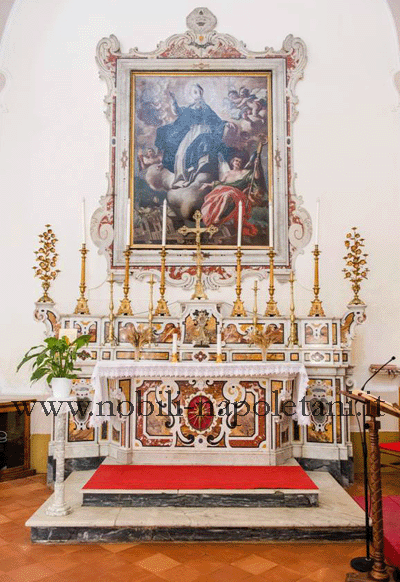
San Domenico Church Lucera – interior Altar donated by
Claudio and Fabio d’Auria in 1575
Dedicated to the Beato Agostino Kažotic |
|

Ancient fresco above the Altar, later covered by
The actual “altarpiece” or painting. |
|
In the Diplomatic Code of Puglia one reads: “Nicolao,
Family of Ferrante I of Aragon, was already patrician of
Lucera in 1463,
Nicola,
grandson of said Nicola senior, was enrolled there to
the 60 some (soma is a land extension measurement)
in 1556 and
Lelio
subsequently in 1556.
Geronimo
was among the elected nobles in 1619 and was enrolled
the 60 some in 1621.
Geronimo Jr,
possessed 60 some in the recognition operated by the
Duke of Laurito in 1694.
Gennaro,
son of Antonio, was added, enrolled and graduated of the
60 some in 1724.
Antonio
is enrolled with the title of Patrician in the land
register of 1754, with his wife, Camilla Veneziani and
the sons,
Vincenzo
and
Domenico.
Tomb and altar are in the San Domenico Church; they had
a palatial building, then inherited by the Secondo,
in the present Oberdan square”. |
|
Patrician of Lucera (“m” which stands for magnificent)
for the descendants
of Gennaro, son of Antonio and of Vincenzo and Domenico
(Vol. 20- 1768,
sons of Antonio (Vol.2. 1754). |
|
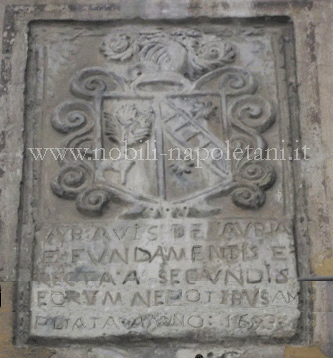
Coat of arms parted with
the insignias of the
Families Secondo and
d’Auria 1693. |
|
First born son of Nicola and Angela Miradois was
Giovanni Francesco d’Auria,
who transferred the d’Auria family to Naples.
Claudio,
second son of Nicola and Angela Miradois was Doctor in
Law (U.J.D.) married
Beatrice Severino of Pietro, in 1576. In 1575,
Claudio with brother
Fabio,
founded the Chapel of Beato Agostino Ungaro (Agostino
Kažotic) still existing in the Church of San Domenico in
Lucera. A testament exists dated December 22nd
1598.
Alessandro
(2.10.1699 – 13.03.1770) Jesuit, was a scholar of the
‘700, author of many works, among which a
“Choice of the Most Memorable events of the Kingdom of
Naples, with exploits of the most famous Captains and
monarchs of the whole Kingdom and still with the
distinct series of the events of Lucera, the principal
city of Puglia”.
The work was edited by Mosca publisher in Naples in
1729. He used a pen name and signed himself Metello
Dariva. His
“Compendium veridical on all the history of Lucera”. (1740).
It was translated from the Latin by Giuseppe Ramamondi.
Alessandro had to undergo the persecution that the
Jesuits suffered in those times. The Prime Minister of
King Charles III of Borbone,
Bernardo Tanucci, wanted to impose a control on
the Church. Alessandro was expelled with the other
Jesuits of the Kingdom. The results for the Jesuits
were, according to the chronicles of the time, “deprivation
of everything and abandoned with their poor belongings
on the beach of Terracina”.
In 1675,
Nicola
d’Auria, great-grandson of
Giovanni Francesco,
reconstructed the memorial chapel in the Church of S.
Luigi di Palazzo, a church which was subsequently pulled
down to make place for the Piazza del Plebiscito in
Naples. One reads in an ancient document
“perpetual and eternal monument of the d’Auria Family of
Naples, descendants of that of Lucera, is the
inscription which is read in the Church of S. Luigi di
Palazzo, on the side of the Chapel “Gentilizia” of
Santissima Annunziata, founded by
Rubino d’Auria,
located on the opposite of the place where you see it
today, and where it was transported in 1675, in occasion
of giving a more decorous form to the Church. Nicola,
Great Grand-father of Don
Pasquale
and grandson of the founder, wishes that the memory of
such a mutation remains perpetual, so that you may erect
the following epitaph”. |
|
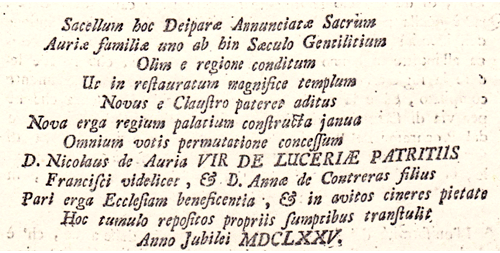 |
|
The d’Auria(s) of Naples maintained their ties with the
city of origin. There exist documents that show how the
d’Auria(s) of Naples were re-acknowledged as belonging
to the ancient noble Family of Lucera and were
“re-enrolled” into the citizenship and with the right to
the 60 some of land.
Gennaro
d’Auria and
Nicola
d’Auria, great-grandsons of the forefather in Naples,
Giovanni
Francesco were “re-enrolled” on the 10
April 1690. Nicola d’Auria, grandson of the aforesaid
Nicola, and Antonio, son of the same Nicola, were
“re-enrolled” in 1724, Pasquale d’Auria, son of Nicola
was “re-enrolled” in 1777. The already cited, Pasquale
d‘Auria was appointed Cavaliere di Giustizia (Knight of
Justice) in the Royal Military Constantinian Order of
St. George. |
|
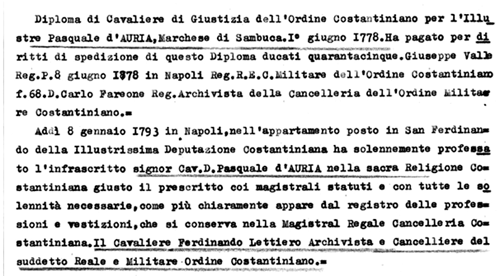 |
|
With Don Pasquale finishes the ancient lineage of the
rich nobles, but the Family d’Auria continues with many
active members in the liberal professions, such as
lawyers, judges and officials of the Armed Forces.
Giovanni Battista
d’Auria (3.09.1814 – 15.01.1884) distinguished himself
and received much appreciation for his firm conduct
which placed under control the criminal underworld of
the territory. To Giovanni Battista was confirmed the
title of Marquis of Spineto. |
|
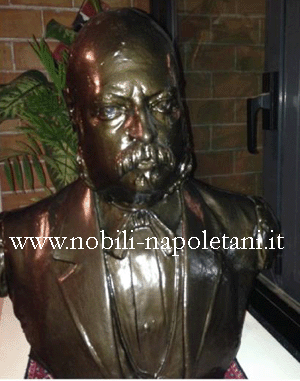
Bronze
bust of Giovanni Battista d’Auria,
Marquis of Spineto |
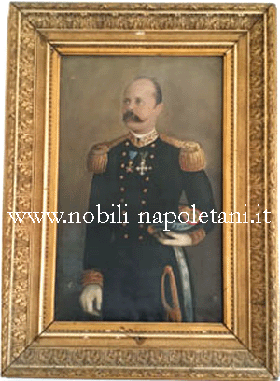
Francesco d’Auria – Marquis of Spineto, son of Giovanni
Battista – oil painting |
|
Francesco
d’Auria, son of Giovanni Battista, was a successful
lawyer and also to him was confirmed the title of his
father. Francesco d’Auria was also nominated Cavaliere
dell’Ordine Equestre of the SS Maurizio and Lazzaro.
Giovanni d’Auria,
General of the Air Force – “Ragazzo del “99” in the
15-18 World War, squadrista in the 1921-22. As pilot, he
participated in the Mediterranean air cruises – he
fought in Ethiopia as Commander of the 11° Wing and then
of the Group of the IX Bombing Squadron. For his valor
he received a promotion for merits of war. In World War
II, he was Commander of the IX Bombing Squadron
distinguishing himself in the air offensive against
Malta and for the attack of enemy convoys in the
Mediterranean. For the sinking of an enemy ship in the
“Battle of Pantelleria“, he was personally decorated by
Mussolini. Benito Mussolini, seeing the ribbon on Col.
d’Auria’s chest, qualifying him as “squadrista”, was
particularly happy and moved and then, noting the other
ribbons and decorations which indicated the many
campaigns, asked
“but
aren’t you tired of going to war?”
Colonel d’Auria replied jokingly that by now the war had
become part of his life and Mussolini laughed heartily
and embraced him.
Colonel d’Auria, valiant pilot, fought in three wars,
multi-decorated, squadrista from the first hour, was
certainly shocked at the news of the arrest of
Mussolini, on July 25 1943. However, having
acknowledged some serious differences of opinion and
discussions among the personnel under his command,
summoned all officers and said
“We are soldiers in the service of the Country and that
which counts for us is only Italy! If it is necessary
for the good of our Country, so must fall Mussolini, IL
Duce and Fascism!” |
|
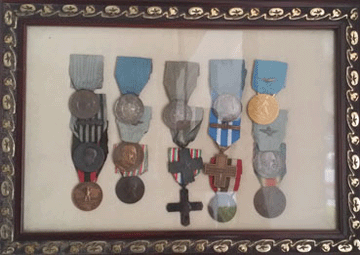
Medals of valor received by Giovanni d’Auria |
|
But he was wrong. At 7:45 pm on September 8th
1943, the radio broadcast the news of the armistice
requested by Italy to the Anglo-Americans. It was not an
armistice, neither, as many hoped, did it open the
prospects of peace – it was an unconditional surrender!
Italy prostrated itself before the enemy which could
dispose of it at will. Colonel d’Auria was dismayed and
said
“It is a disgrace! An humiliation which will remain
throughout history”.
He joined the RSI, wishing to continue fighting for the
sake of honour; after the war, he was arrested many
times, tried at the risk of his life, then dismissed
from the Air Force. He was persecuted and suffered
untold humiliations, all borne with courage and great
dignity – never wanting to bow to compromise.
Accompanied by a military escort of honour on November
21st 1975, he was laid to rest in his
General’s uniform – shrouded in the Italian flag.
Adriano
d’Auria (branch of Tolve) was Brigadier General,
Military Officer at the Italian Embassy at Riad (Saudi
Arabia). Among the honours bestowed on him, he was
conferred the Cross of Cavaliere dell’Ordine
Militense.
Eugenio
d’Auria (Branch of Tolve) 1948 was the Italian
Ambassador in Saudi Arabia. |
|
TITLES of NOBILITY and FIEFDOMS |
|
Earlship of Volturara, Marquisate of Spineto (ab antique
with confirmation in 1851 and in 1889). |
|
NOBLE FAMILIES RELATED TO THE d’AURIA (S)
|
|
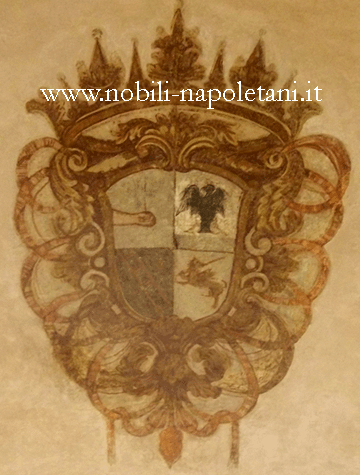 |
|
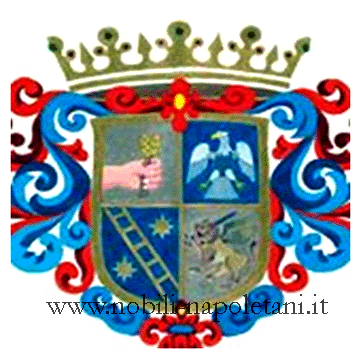 |
|
On the side: coat of arms of the d’Auria Family,
quartered with the coat of arms of the Caropresa
Family.
Above: the coat of arms of the Family d’Auria,
quartered with the coat of arms of the Secondo
Family. |
|
|
Among the many:
Arcella, d’Afflitto, d’Anna, de Attellis (Dorotea
d’Auria, noblewoman of Lucera, wed Francesco de Attellis
of the Marquises of Sant’Angiolo Molisano and they
procreated Caterina who, on January 28 1806 married
Francesco del Martino), d’Avalos, Bonito, Capigrecco,
Capuano, Castaldi, de Contreras, de Corradis, Corrado,
Del Buono (Castello di S.Agata in Puglia, de Deora, del
Duce, Engelsby Hansen, Falcone, Filjeta, Filangieri, (Geronima
d’Auria, nobile di Lucera wed Ferrante Filangiere,
brother of Niccolò Antonio (died 1547) Baron di Mancusi
e Lentace, Angela Humphries, Landolfo, de Liguori (the
d’Auria(s), thanks to the many family ties with the de
Liguoris conserve in family the Cross of Sant’Alfonso
Maria dè Ligori), Lucarelli d’Avalos, Ippolito de Majo,
Miradois, de Mobilia, Mollè, Monaco, Moscatelli,
Napodano, Navarra, Pagano, Pisanelli di Ravello, della
Ratta (Gugliemo married Lucia della Ratta around 1050)
Rho Confalone, Sant’Angiolo, Scoppa, Secondo, Severino,
Tafuri, de Tommaso, Toraldo, Vallin, Vango of Aragon,
Veneziani. |
|
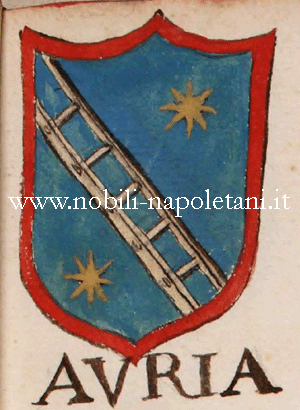
Coat of arms of the d’Auria(s) of Lucera –
manuscript of the XVII Century. |

Coat of arms of the d’Auria(s) of Lucera –
manuscript of the XVII Century. |
|
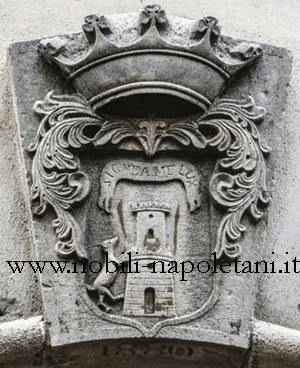
Rocchetta – coat of arms of the Ippolito Family. |
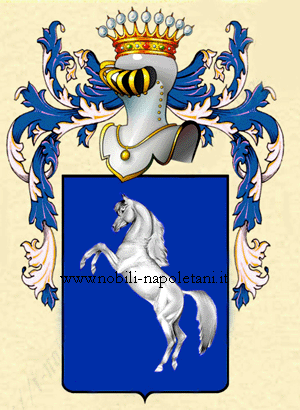
Coat of arms of the Napodano Family
(7) |
|
Notes:
1) -
Privilege of Andrea, King of Naples and Sicily to
Antonio d’Auria 25th July 1343.
2)
- Auria was a proper name of persons of Longobarda
origin
derived from the Latin Aurea. Lucera was under the
dominion of Longobardi until 892 when it passed under
the Byzantine dominion.
3) -
Collocation ARCA 4. N° 56 and also “Italia Sacra” by
Ughelli, Chapter 25. Doc. CCCCXXXIV AD 990.
4) -
Ref. C.A. Caggiano “L’amministrazione Periferica
Longobarda in Puglia. Gastaldi and Gastaldati in
“Vetera in Christianorum” XIX, 1982, 361-372,
partic. 371-372.
5) -
Great Archive of the Royal House, 1195.
6) - General History of the
Kingdom of Naples (1748). Volume III page 396.
7) - Carlo Padiglione
“Thirty Centuries of Noble Families”. Forni Publishers,
Bologna, 1968. |
|
Copyright © 2007
-
All rights reserved
|
|